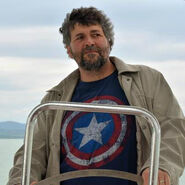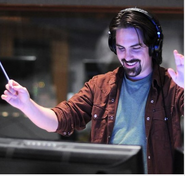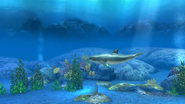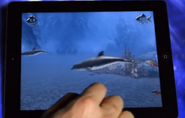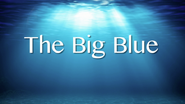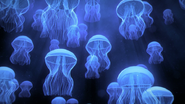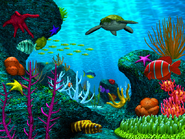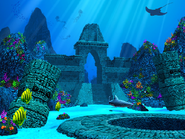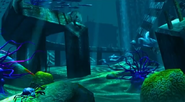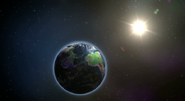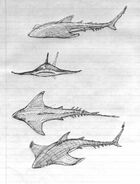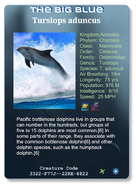The Big Blue is a new underwater adventure video game currently being created by Ed Annunziata and the original Ecco the Dolphin team as a spiritual successor to the Ecco series. The composer, Spencer Nilsen, and game designer, Laszlo Szenttornyai, are both reprising their roles from the production of the original series. The Big Blue is a new underwater adventure game centered around cetaceans, but this time a large variety of creatures will be playable and have unique roles. The game hopes to explore new angles and concepts not previously seen in underwater adventure games before. The gameplay and story themes in the game will be both familiar and new to long time Ecco fans.
Between March 25 and April 29, 2013, Ed and the team turned to Kickstarter to gather funding for the game, but unfortunately only $55,764 out of the needed $665,000 was pledged and the game did not get funded. Ed will be returning to Kickstarter with a smaller version of the game and prequel, The Little Blue. The date for its Kickstarter launch and funding goal have not yet been announced. Once The Little Blue is released, Ed will again return to Kickstarter with a new pitch to fund the final version of The Big Blue. The Big Blue will not be the end of the series and Ed plans on keeping it going in various forms.
Platforms[]
Currently, The Big Blue is planned for release on Windows, Mac, Linux, iOS and Android. Once the game is released, Ed plans to push for versions of the game to be released on Sony, Microsoft and Nintendo platforms to expand the game's audience. The team is currently experimenting with an Oculus Rift development kit for the purpose of the game possibly supporting the device. The game will NOT require an internet connection to be played.
Development[]
The Big Blue is being developed by Ed Annunziata's company, Playchemy, and Spencer Nilsen's studio, Illumina. The game is being developed in the Unity engine.
Gameplay[]
The Big Blue is an underwater adventure game where the player will control dolphins and other sea creatures, each with special purposes, advantages & disadvantages, and a unique feel to the play control. The game will feature 2D gameplay with 3D graphics in 3D environments. As a 2.5D game, The Big Blue will not be on rails like a traditional side-scroller, but will have branching paths and other ways for players to explore in a 3D environment. According to Ed:
"Nights is a good comparison but that POV/Control scheme was too restricted. If you remember the player character was rigidly stuck on a curvy 2D plane. Our creatures won't be stuck on the "ribbon" but will loosely follow a path. For example they will swim in or out of the Z plane to avoid something in it's path."
Gameplay Mechanics[]
- The game will be beatable and have a story.
- Echolocation
- Singer technology
- Surface interaction: How things interact with the surface of the water when they break through or enter it.
- Puzzle solving
- Quests
- Emphasis on exploration
- Creature capture, spawning, breeding and creation
Controls[]
The currently planned methods of control input are: analog stick (controller), keyboard and touch controls. According to Ed:
"The basics of creature control is to aim, or point in a direction, and propel - make the creature swim forward.
Analog Stick
Left steers the creature in absolute, screen relative direction AND propels it in the direction based on the distance from center.
Right stick is camera controls: Zoom and semi circle orbit.
Buttons invoke songs and other game options.
Keyboard
Same as stick but uses arrow keys and other keys for songs and options.
Touch Screen
I have several ideas, all of which I want to explore. The goal is to give a good feel to the touch screen input. By nature touch is a bit disconnected - its good for buttons but not really good to steer something around."
Control Schemes[]
Ed has shared the following details about possible control schemes:
Medusa Control
"Controlling a jellyfish has severe limitations which are designed to somewhat match the limitations of the creature, for example, they are blind. Rather than displaying black on the screen we will move the camera very tight up to the Jelly. It will mostly fill the screen. This means you won't be able to see whats ahead of you or behind you.
Movement is restricted as well: 2 inputs
- Aim - Rotate the Medusa
- Pulse - undulate the Medusa to propel forward.
What are the advantages of controlling a Medusa?
- Most other creatures will leave you alone
- you can swim very deep, there is not depth limit to most Medusas - other creatures cannot dive so deep.
- They are very poisonus and can be considered a weapon. Their tendrils will sting anything they touch."
Swarm Control
"Many fish in the Big Blue will be schooling fish that exhibit "flocking behavior" You'd seen giant flocks or swarms of birds or anchovies. They move together and seem to form a separate super creature. The swarming fish follow these simple rules:
1. Move in the same direction as your neighbors
2. Remain close to your neighbors
3. Avoid collisions with your neighbors
If thousands of fish follow these rules you get a massive swarm.
If you are controlling a swarming fish you simply swim near other of the seam fish and they will join your swarm. The more fish you pick up the bigger swarm you can make. Even though you will only control one fish the swarm will follow.
This control is limited to direction only. There are no other inputs, however you will be able to grow and 'sculpt' a large cloud of fish and in the context of some game quests, the swarm will come in handy!"
Creatures[]
All creatures in the game will be playable after being unlocked through one method or another. Depending on which creature you are playing as, other creatures will hunt you down in a predatory fashion. There will be a fairly well developed AI to create these underwater ecosystems. According to Ed:
"Basic behaviors of enemies would include:
- Swim away from you
- Attack you if you are within range
- protect a territory (only attack if you enter an area)
- Protect another creature
- If you cross it's path it attacks
- Once it sees you it stalks you (at various lengths of persistence)"
Story[]
Like the Ecco series, The Big Blue takes place in a world without humans. The game will take place one million years after the extinction of humans. Over the course of this million years, the ocean has become sentient (like in Trellia's future), its lifeforms have evolved and new species have emerged. The game will not only focus on discovering what happened to humans, but will also focus on dealing with the fallout and legacy from their time on Earth. Gyreforms, mutant inorganic species spawned from the pacific garbage gyre, will be some of the most dangerous creatures in the game.
In this new evolved ocean, Singers (cetaceans) have formed their own unique societies. One such example is a Super Pod a million dolphins in size with a collective, synched mind sharing information through song. Another Singer society is the Archaeologists: singers searching for answers about the extinct human society and excavating their ruins. Not only have singers evolved on the intellectual level, but so have their songs. In addition to being used as a method of communication, information transmission and echolocation, their songs have amazing new powers, like the ability to create and spawn life or physically repulse other creatures as a defense mechanism.
In addition to science fiction themes, part of the game's story will be the Gaia theory: the idea that the Earth is a living thing. Ed hopes to not only show how the ocean evolved and changed after the human race died off, but convey how life copes, adapts and survives in harsh situations. Another concept the game will tackle is the idea of all life and DNA being information. The team hopes the game will change the way players think about nature, the ocean and our planet. Other themes include climate change, mass extinction, predation, evolution and biogenesis.
Atmosphere[]
Similar to Ecco the Dolphin, The Big Blue hopes to make underwater environments that are both beautiful and frightening. Music and sound will both be a very important side of the game to create these atmospheric environments for the player. The game will utilize a unique musical engine that changes in real time to reflect the changing situation in the game. The lighting in the game will get progressively darker as the player-controlled creature swims deeper down into the ocean.
Other[]
After the game is completed and released, the game can be connected to a server to receive updates, get new content and to view player statistics.
Team[]
Links[]
Ed Annunziata's Twitter - Get the latest news from Ed!
Playchemy Community Forums - The official forums for The Little Blue and The Big Blue. Ed and the team are seeking feedback about the games here and also post the latest updates on the boards.
Illumina Studios Website - Website for Spencer Nilsen`s studio working on the game.
Original Big Blue Kickstarter Page - Funding window has closed.
Original Big Blue Kickstarter Video - Original Kickstarter video pitch.
Interviews and Other Press Releases[]
Fighting the Tide: The Struggle to Revive Ecco the Dolphin - Polygon piece on Ed's history as a developer and information prior to The Big Blue Kickstarter launch.
Sega Nerds Interview - Ed talks about the history of Ecco and plans for The Big Blue.
Gamespot Interview - Ed discusses the early history of Ecco and his plans for The Big Blue / Little Blue.
Eurogamer Interview - Ed reflects on The Big Blue's failed Kickstarter and gives more information about the history of Ecco. He also talks about his plans for The Little Blue and The Big Blue.

